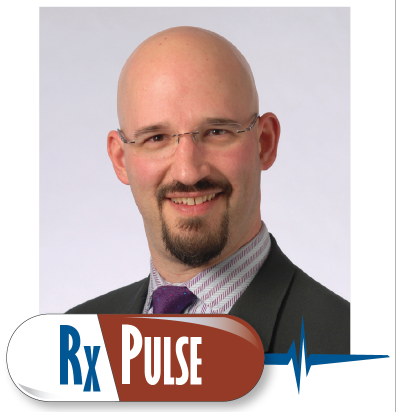
|
By Don Selzer, MD
Associate Professor of Surgery,
Willis D. Gatch Scholar and Chief,
Division of General Surgery,
Indiana University School of Medicine |
Note: The following article is based on a free CME webinar Dr. Selzer presented for ISMA as president of the American College of Surgeons, Indiana Chapter. He is now immediate past
president.
In the last 20 years, surgical care has experienced dramatic changes, including a shift from inpatient to outpatient care, ever-growing efforts to afford minimally invasive options and a thorough examination of outcomes, including surgical site infections and length of stay. The opioid addiction epidemic has shone a light on another facet of perioperative care worthy of examination: pain control.
In the 1980s and 1990s, multiple groups demonstrated limited medical knowledge surrounding opioids and, ultimately, a failure to address postoperative analgesia appropriately. A one-paragraph summary of a report by Hershel Jick, MD, and Jane Porter, published as a letter to the editor of the
New England Journal of Medicine in 1980, helped alleviate concerns that those who required opioids for postoperative pain relief were likely to develop addictions. In the late 1990s, the Veterans Administration and the Joint Commission on the Accreditation of Healthcare Organizations (JACHO) announced pain assessment as “the fifth vital sign” and initiated a focus on alleviating unnecessary suffering for surgical patients. As a result, physicians provided patients with any reasonable dose of opioids to meet the perceived need.
Fast forward to 2011, when researchers from several institutions reviewed large hospital claims databases for previously opioid-naïve patients who filled an opioid script immediately after discharge and then more than 90 days after discharge. They found that 6 percent of recently discharged patients developed a new opioid dependency. The highest-risk groups were those who were discharged following a surgical procedure; those who had prior addictive behavior, including tobacco or alcohol dependency; and those with a previous mood disorder diagnosis. Surgical procedures found most likely to generate a new opioid dependency included total knee arthroplasty, total hip arthroplasty, total mastectomy, and open cholecystectomy. Researchers have also shown that patients who arrive for surgery already on opioid pain medications experience 10 percent higher overall hospital costs, 4 percent more complications, 12 percent longer hospital stays and 4 percent more readmissions.
Recognition of these patterns demonstrates a need for change in the use of opioid analgesics in perioperative pain control. An assessment of current practices reveals an opportunity for standardization and a need to reduce reliance on opioids, replace opioid analgesics when possible, educate ourselves and our patients regarding opioids and perioperative pain control expectations and communicate more effectively with patients and other health care providers prior to and following a surgical procedure.
Reduce reliance on opioids
Work done primarily at Dartmouth and Michigan has demonstrated wide variation in the prescriptive practices of surgeons performing common, straightforward surgical procedures. In addition, these groups showed the amount of opioid pills prescribed sometimes exceeded the need tenfold. In other reviews of general, orthopedic and gynecologic surgeries, patients only take about 25 percent of prescribed pills (range of 10 percent to 90 percent). In an effort to reduce variability and excessive prescribing, the groups at both Dartmouth and Michigan have generated prescribing guidelines for these less complex outpatient procedures. For more complex cases, the team at Dartmouth developed a prescribing algorithm based upon inpatient opioid utilization at the end of the hospital stay. Ultimately, sharp reductions in the quantity of prescribed pills does not appear to increase the propensity to request a refill and does not appear to impact patient experience.
Replace opioid analgesics when possible
The advent of enhanced recovery after surgery (ERAS) protocols has focused efforts on reducing length of stay and postoperative morbidity. The impact of opioids on return of bowel function following gastrointestinal and non-gastrointestinal surgery is clear. As a result, emphasis on a multimodal method of perioperative pain control replaces a reliance on opioids with other options, including nonsteroidal anti-inflammatories,
acetaminophen, gabapentin and alternative options, including mindfulness, focusing on breathing and acupuncture. In addition, efforts to reduce pre-operative doses of chronic opioids and replace them with alternates may reduce postoperative reliance on higher doses of opioids and reduce the impact on length of stay and overall health care costs.
Educate ourselves and our patients
Although surgeons themselves may benefit from education on new prescribing guidelines and enrollment of alternative pain control methods in a multimodal approach, it’s imperative that patients are appropriately prepared for the postoperative experience. Well-developed and easily understood materials for surgical patients are available free of charge from the American College of Surgeons and the Michigan Opioid
Prescribing Engagement Network (OPEN). Materials from both sources provide patients with an appropriate basic understanding of a multimodal method of pain control and work to establish realistic expectations.
Communicate more effectively
Many times, a physician’s failure to discuss the use of opioid pain medication with a patient or a lack of communication between health care providers regarding a mutual patient leaves open an opportunity for misuse and diversion. Surgeons, known for their candid nature, are well-equipped to lead the discussion of complex patient management to reduce the potential for misadventure.
It is no longer acceptable for surgeons to apply a one-size-fits-all approach to postoperative pain control. Although well-intended, a tendency to oversupply patients with opioids left the door open for inappropriate use. Reports continue to demonstrate a correlation between surgical admissions and the development of opioid addiction in a small but consistent percentage of previously naïve patients. Who better to prepare patients and set expectations regarding postoperative pain than the surgeon specialists who perform the procedures? Fortunately, organizations such as the American College of Surgeons and researchers from reputable academic institutions have begun to arm physicians with the tools needed to impact the outcome of this battle.
Note: This article expresses the personal views of the author and not ISMA.